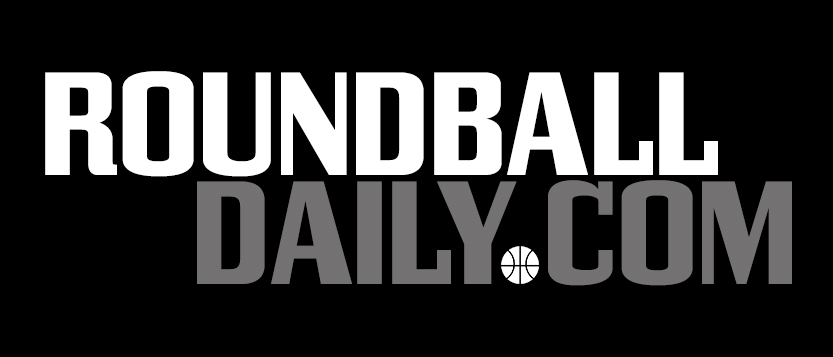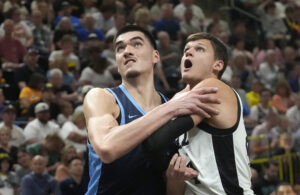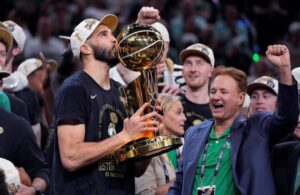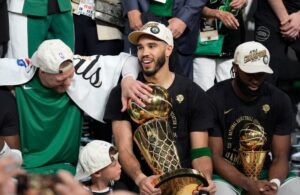- Zach Edey posted an easy double-double in Summer League debut. Here’s why he’ll succeed in NBAPosted 2 weeks ago
- What will we most remember these champion Boston Celtics for?Posted 1 month ago
- After long, seven-year road filled with excruciating losses, Celtics’ coast to NBA title felt ‘surreal’Posted 1 month ago
- South Florida men’s basketball is on an unbelievable heater– but also still on the bubblePosted 5 months ago
- Kobe Bufkin is balling out for Atlanta Hawks’ G League team. When will he be called up to NBA?Posted 6 months ago
- Former Knicks guards Immanuel Quickley, RJ Barrett may yet prove Raptors won the OG Anunoby tradePosted 7 months ago
- Rebounding savant Oscar Tshiebwe finally gets NBA chance he’s deserved for yearsPosted 7 months ago
- Is Tyrese Maxey vs. Tyrese Haliburton the next great NBA guard rivalry?Posted 8 months ago
- The Detroit Pistons are going to be a problem in a few yearsPosted 9 months ago
- March Madness hero, ex-Fairleigh Dickinson guard Demetre Roberts joins Austin Spurs’ G League training camp rosterPosted 9 months ago
NCAA passes rule allowing players to return after putting name in NBA Draft
- Updated: January 14, 2016
(NCAA)–Students competing in men’s basketball now have a better opportunity to assess their likelihood of success in the NBA without jeopardizing their college eligibility.
In an effort to both provide students the chance to make more fully informed decisions and prepare themselves for a potential professional basketball career, the Division I Council on Wednesday adopted a proposal that, among other provisions, changes the date by which a student must remove his name from the NBA draft.
The change is effective immediately, and students can take advantage of the new process for the 2016 NBA draft.
“The rule is a good idea because it provides men’s basketball student-athletes the opportunity to test their dream of going beyond the stage of amateurism into the professional level without completely sacrificing their collegiate career, should they find they are not as prepared as they had hoped for the next level,” said Cody McDavis, a member of the Division I Men’s Basketball Oversight Committee.
A recent graduate of the University of Northern Colorado who will enter law school at the University of California, Los Angeles, this fall, McDavis helped craft the new rule.
“(The rule allows) student-athletes to realize their dreams without punishing them for having such dreams. Almost every men’s basketball student-athlete has dreamt of playing in the NBA. This proposal allows them to attempt to make those dreams a reality without taking away their ability to come back and play in amateur collegiate sport if they happen to be unsuccessful.”
The rule, recommended by the Men’s Basketball Oversight Committee, is the result of extensive collaboration among the NCAA, NBA and the National Association of Basketball Coaches, which worked together to provide more flexibility for men’s basketball student-athletes with professional aspirations.
Dan Guerrero, chair of the Men’s Basketball Oversight Committee and athletics director at UCLA, said the new rule would help students make decisions with as much information as possible.
“The cooperation between the NCAA, NBA and NABC was vital to the success of this idea. We reached an excellent outcome that will undoubtedly benefit every group involved, most importantly the student-athlete,” Guerrero said. “We all worked toward the same goal – providing students and their families with the opportunity to assess their future professional sports prospects in a realistic timeline. The rule change will allow students the chance to pursue their dreams while still preserving their ability to play collegiately.”
Starting this year, a men’s basketball student-athlete must remove his name from the NBA draft list 10 days after the conclusion of the NBA draft combine. This past year, the combine was held May 13-17.
Also, students can enter the NBA draft multiple times without jeopardizing eligibility and may participate in the combine and one tryout per NBA team, per year.
The NBA will invite a select number of draft-eligible players to the combine, which will provide a good indicator of an underclassman’s draft potential. Following the combine, the NBA will provide specific feedback. Students can also work out for one NBA team to provide additional assessments.
A student invited to the combine will be allowed to work out with his college coaches from the time he receives his invitation until he withdraws from the draft. Workouts will be kept to the in-season limit of four hours a day for up to 20 hours per week.
Usually in late April and May, men’s basketball student-athletes are limited to eight hours per week of skill instruction, conditioning and film review, not to exceed two hours of skill instruction. Practice is prohibited surrounding final exams.
The Council added the practice piece to the proposal in September in order to encourage students to stay on campus and complete their academic coursework for the semester while giving them access to top-level coaching. Also, Council members believe that students who remain on campus are less likely to receive improper benefits from agents that could result in eligibility issues if the student decides to return to school.
McDavis noted that the limit on the number of students invited to the NBA-sponsored combine will likely encourage many uninvited students to return to school, particularly when paired with the new flexibility.
“I am of the belief that a student-athlete who does not receive an invite to the draft or an invite to work out with a team will make the smart decision to return back to college to continue to grow as a player,” he said. “However, should they receive an invite, they will have an opportunity to compete against draft-potential competition and receive feedback on their performance. Either way, they have an opportunity to make an educated decision that is best for them and their family. That is why this is so important.”
The rule change reverses a 2009 decision to move the date by which students must remove their name from the draft to the day before the spring signing period in early April. Though the rule change will make roster planning more difficult for coaches who will have to wait until as late as late May to know whether their top players are returning to school, coach support through the NABC was critical.
Bill Self, University of Kansas head coach, said the benefit to student-athletes is immeasurable.
“This legislation, with help from the NBA, will allow student-athletes the opportunity to make informed decisions on their true status as a draft prospect before forfeiting their collegiate eligibility,” Self said.



